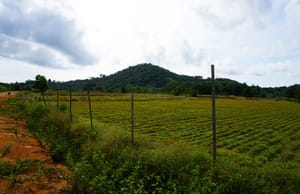SLIGHTLY NORTH OF Bukit Mertajam is a low cluster of peaks, including Bukit Gua Gempas and Bukit Langkap, with the latter bordering the Butterworth-Kulim Expressway (BKE). While looking for a new place to hike in mainland Penang, I came across many online references to Bukit Suling— which, after research, turns out to be a spot located on the slopes of the 180m-tall Bukit Langkap. Looking at photos of its summit views, I am immediately convinced to plan a hike there.
- Home
- Peaks and Parks
- Bukit Langkap: A Modest Hill With a Splendid View
Bukit Langkap: A Modest Hill With a Splendid View
by
Rexy Prakash Chacko

Previous Post
National Heroes to Remember and Reward
5 min read
THE LAST TIME Malaysians experienced a full-scale conflict in their homeland was probably more than 35 years ago, before the…
Next Post
Joachim Bergström: On Using Universal Values to Drive Diplomacy
12 min read
As his tenure comes to an end, Penang Monthly sits down with Joachim Bergström to talk about his team’s efforts in introducing these universal values to the country, and how these can strengthen the bilateral relationship between Sweden and Malaysia.
You might also like
Exploring Bukit Batu Itam: Penang National Park’s Highest Peak
6 min read
While most visitors opt for the trails leading to Pantai Kerachut and Teluk Kampi, one path excites hikers seeking a challenge— the Bukit Batu Itam trail. Rising to 460m above sea level, Bukit Batu Itam is the tallest peak within PNP.
Bukit Papan: A Little Paradise Overlooking Penang’s South
6 min read
The hills in the southern part of Penang Island may have a lower elevation than the peaks in the north, but they are just as fascinating. While the allure of Penang Hill and the peaks in the north lie in their biodiverse rainforests, the experience in the south is pretty different.
When The Waters Recede: Walking to Batu Ferringhi Isle
6 min read
Often called Lover’s Isle by locals, Batu Ferringhi—or Foreigner’s Rock—is the very isle that lent its name to the long stretch of coastline beside it, now one of Penang’s tourist attractions.



